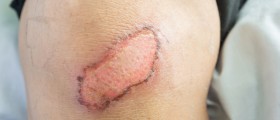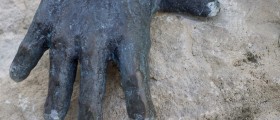When a bone is broken it needs to be put back into its proper position and then time needs to be allowed for the bone to heal itself.
All bones go through the exact same healing process, even if it was cut in surgery or broken in an injury.
Stages of Healing Process
Three stages in the healing process overlap with one another; they are inflammation, bone production, and bone remodeling.
As soon as the bone is broken, the inflammation begins, and it lasts for several days. A bone fracture results in bleeding, which leads to inflammation and blood clotting at the site where the fracture occurred.

This process provides structural stability and makes way for new bone to be produced.
When the clotted blood is replaced with fibrous tissue and cartilage, this is when the production phase begins. The cartilage is replaced with hard bone in this phase. The bone remodeling phase, which is the final one in the healing of the injury, can last several months.
The bone continues forming and it becomes compact, returning to its shape before the injury. In this phase, blood circulation improves in the area.
Once the bone has healed enough, activities such as standing and walking, especially if it is a broken leg bone, will encourage the remodeling process.
It all depends on how severe the injury is, but most bones can heal in a matter of six to eight weeks. Children’s bones heal faster than adult bones.
How To Speed Up Recovery Process
Often, doctors will recommend a special diet to help the process along. Usually, patients are recommended to stop smoking and decrease their glucose intake.
A major part of successful bone healing is immobilization because any movement of the bone fragments can slow down the healing process. In more serious cases, the surgeon will use screws, wires, or plates to keep the bones in place, but in less serious cases, a cast will do just fine.
Once the bone has healed, rehabilitation is also important. Exercise programs for regaining strength and balance are encouraged.
What to Avoid
Some things can stunt the process of healing. Smoking, as mentioned earlier, decreases circulation. Medical conditions such as diabetes and hormone-related problems can also slow down the process. Infections will also slow down healing, as well as poor nutrition and an impaired metabolism.
It is best to consult a doctor or nutritionist regarding what the optimal diet is to help promote a quicker healing of the broken bone.
- While most fractures heal uneventfully, fracture-healing complications such as delayed union, nonunion, and malunion do occur. In tibial shaft fracture, nonunion has been reported to occur in up to 10–20% of patients.
- Because the etiology or pathophysiology is not always clear, a variety of factors have been hypothesized to contribute to the development of fracture-healing complications. While some of these factors are fracture and/or quality-of-surgery-dependent, many of them are related to patient attributes and lifestyle (e.g. age, sex, diabetes, use of medications such as corticosteroids and non-steroidal anti-inflammatory drugs (NSAIDs), smoking, excessive alcohol use, and poor nutrition).
- Briefly, the GPRD is an ongoing longitudinal database that collects data on more than five million patients from over 400 general practices in the UK. The database is population-based and representative of the underlying UK population with respect to age, sex, and geographic distribution. Information recorded in the database is entered by general practitioners (GPs) who function as gatekeepers for hospital and specialist referrals in the UK health system, and it includes patient demographics, diagnoses (recorded using the Oxford Medical Information System codes and/or Read codes), consultant referrals, and drug prescriptions.
- We identified cases from all individuals registered in the GPRD who had a diagnosis of a fracture-healing complication (i.e. delayed union, nonunion, malunion) between January 1988 and May 2008 and who were aged 18–79 years on the date of diagnosis. We required that cases had a site-specific diagnosis of a fracture within 12 months before their fracture-healing complication diagnosis. We also required that cases had at least 1 year of history recorded in the database before their diagnosis, to ensure that there was sufficient time to capture risk factors.
- Diabetes and use of non-steroidal anti-inflammatory drugs (NSAIDs) within 12 months before the initial fracture were associated with a higher odds of a fracture-healing complication (type-I diabetes: adjusted OR = 2.3, 95% CI: 1.3–3.8; type-II diabetes: adjusted OR = 2.3, CI: 1.4–3.7; NSAIDs: adjusted OR = 2.6, CI: 2.1–3.2). Patients who had a motor vehicle accident recorded within 1 month before their initial fracture were also at increased odds of a fracture-healing complication (adjusted OR = 2.6, CI: 1.2–5.4).

















Your thoughts on this
Loading...